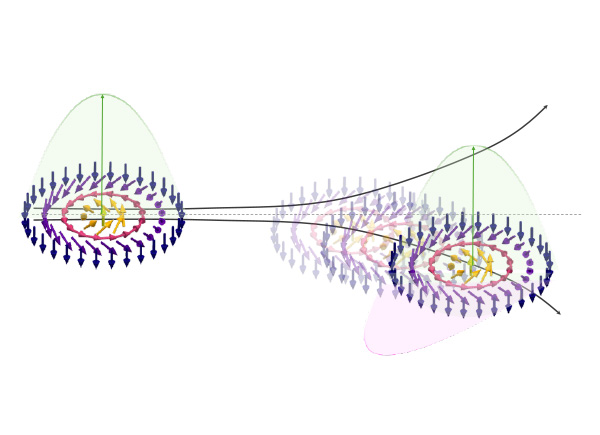Dec. 19, 2024 Research Highlight Physics / Astronomy
The motion of magnetic whirlpools is all relative
A new way of thinking about how swirling magnetic textures and mobile electrons interact could lead to compact, efficient and robust electronic devices

Figure 1: The topological Hall effect (top gray arrow) and skyrmion-lattice motion (bottom gray arrow) are observed to cancel each other out in the compound gadolinium palladium silicide. © 2024 Springer Nature
The future storage and processing of data stand to benefit greatly from tiny magnetic whirlpools known as skyrmions, which are robust against noise and may be useful in lower power consumption devices. The development of skyrmion-based technologies has received a boost from a simple and intuitive model for visualizing the complex motions of skyrmions developed by RIKEN researchers1.
In addition to having mass and electric charge, electrons also possess spin—a form of intrinsic angular momentum.
In some crystalline materials, nearby electrons orient their spins relative to each other to form strange patterns. A skyrmion is one such example where the spin at the center points directly upward, while the surrounding spins gradually twist and point downwards to create a magnetic vortex.
As an electron moves through a lattice of skyrmions, its path bends due to the net (or ‘emergent’) magnetic field created by the skyrmions—a phenomenon known as the topological Hall effect. But this flow of electrons also causes the skyrmion lattice to move, resulting in an emergent electric field.
Given this complicated interplay, Max Birch and his colleagues at the RIKEN Center for Emergent Matter Science wanted to investigate what happens to the topological Hall effect when a skyrmion lattice moves.
The team chose the compound gadolinium palladium silicide (Gd2PdSi3) because its topological Hall effect is almost 100 times larger than those of similar materials. Their samples were also relatively small, making it easier to reach the high currents required to track skyrmion motion over micrometer length scales.
The researchers discovered that the skyrmion lattice motion totally canceled out the topological Hall effect (Fig. 1).
“It turns out that the topological Hall effect essentially scales with the velocity of the electrons relative to the skyrmions,” explains Birch. “Once the skyrmions reach the same velocity as the electrons, the topological Hall effect will vanish, since it is totally canceled out by the induced emergent electric field.”
An intuitive way of looking at this is that when the electrons and the skyrmions are moving at the same speed, their relative velocity is zero, and so there is no topological Hall effect.
Ironically, this demonstration on skyrmions, which are promising for forming the basis of future devices, means that they can be described by equations developed more than a century and a half ago. “We’ve shown that the topological effects can be expressed analogously to Maxwell’s equations of electromagnetism,” explains Birch.
This way of looking at skyrmion dynamics will be crucial for developing spintronic devices, the researchers believe.

Max Birch using an experimental system for investigating skyrmion-lattice motion in gadolinium palladium silicide. © 2024 RIKEN
Related content
- Scientists use heat to create transformations between skyrmions and antiskyrmions
- An electrical change of phase using skyrmions
- Scientists successfully manipulate a single skyrmion at room temperature
Rate this article
Reference
- 1. Birch, M. T., Belopolski, I., Fujishiro, Y., Kawamura, M., Kikkawa, A., Taguchi, Y., Hirschberger, M., Nagaosa, N. & Tokura, Y. Dynamic transition and Galilean relativity of current-driven skyrmions. Nature 633, 554–559 (2024). doi: 10.1038/s41586-024-07859-2
